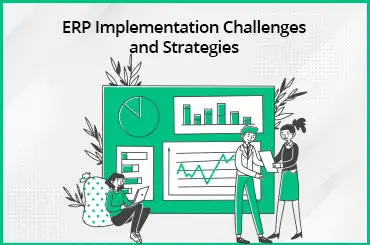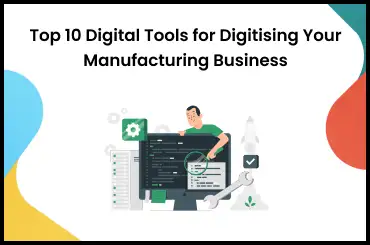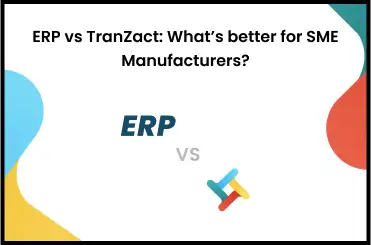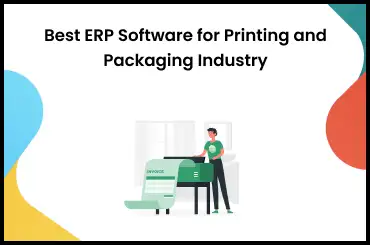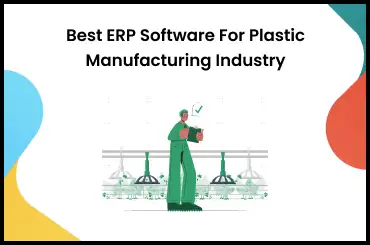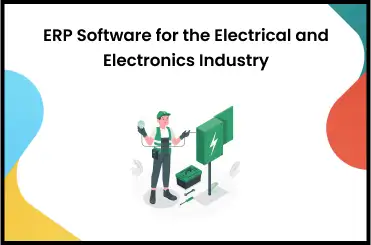Understanding ERP data migration can be both exciting and daunting. As businesses evolve and grow, the need to streamline operations and optimize efficiency becomes essential.
That's where Enterprise Resource Planning (ERP) data migration comes into play - a process that involves transferring vital business information from one system to another.
However, without careful planning and execution, this endeavor can quickly become a challenge. This comprehensive guide will equip you with essential tips and ERP data migration best practices to enable a seamless and successful experience.
From mapping out your data migration strategy to mitigating risks and ensuring data integrity, we'll cover all the crucial aspects you need to consider.
What Is Data Migration?
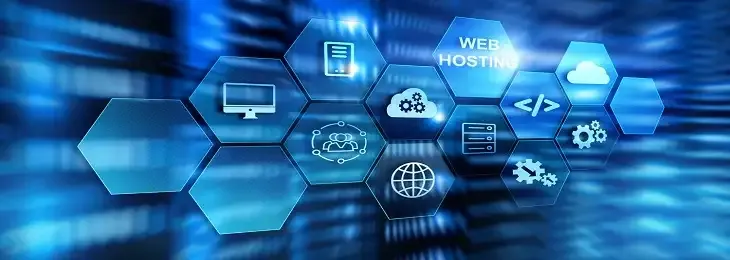
Data migration is transferring data from one system or platform to another. It involves extracting data from the source system, transforming and cleaning it as necessary, and loading it into the target system.
Data migration is commonly performed when organizations adopt new software applications, upgrade existing systems, or consolidate multiple systems into a unified platform.
This intricate process requires careful planning and execution to ensure the integrity, accuracy, and consistency of the data being migrated.
It involves mapping data fields and structures between the source and target systems and implementing appropriate validation and error-handling mechanisms.
Read Also - Production Planning and Control Explained
Key Takeaways For ERP Data Migration
- Stakeholder support, integrity issues, and time and cost issues are all challenges to data migration.
- It is critical to develop a clear plan for migrating ERP data. Create a team that analyzes the data, migrates it, and validates the results.
- The migration process should start early to prevent ERP deployment from being delayed. It also helps migrate old historical data and weed out obsolete records.
Why Is Data Migration So Critical During ERP Implementation?

Data migration is crucial in successfully implementing an ERP system. Organizations strive to centralize and integrate their various business functions during an ERP implementation into a single, unified platform.
The importance of data migration lies in its ability to preserve the integrity and accuracy of data, ensuring that the new ERP system operates with up-to-date and reliable information.
The data migration process in the ERP system enables organizations to take full advantage of the advanced features and functionalities offered by the ERP system.
It allows for the consolidation and centralization of data by providing a unified view of information across departments. This centralized data enhances data accessibility, promotes collaboration, and enables better decision-making based on real-time insights.
Read Also - What Is Manufacturing Overhead?
Challenges With Data Migration

There are various challenges that an organization can face during the ERP data migration:
1. Duplication and Integrity of the Data
Data duplication refers to the redundant data in a system. It can happen when different departments have different copies of the same information. During the data migration process, if data is not checked correctly, it can lead to redundant data being transferred to the target system. Thus, it is crucial to identify and eliminate redundant data before migrating it to ensure data integrity.
2. Cost Related to Data Migration
ERP Data migration can be complex and resource-intensive. It involves various tasks such as data extraction, transformation, cleansing, and loading, which require skilled professionals and proper resources.
Data migration costs include data cleansing tools, personnel training, validation, and testing. Thus, managing and controlling these costs is a significant challenge when planning and executing a data migration project.
3. Regulatory Issues
ERP Data migration often involves transferring sensitive information, such as personally identifiable or financial data. When handling such data, organizations must comply with various regulatory frameworks and data protection laws. Failing to comply with regulatory requirements can result in legal consequences, financial penalties, and loss of customer trust.
4. Involvement of stakeholders
This is a challenging aspect of ERP data migration. It refers to gaining support and commitment from key stakeholders, including executives, department heads, and end-users. This issue arises due to a lack of understanding, misaligned expectations, involvement, and ownership.
Read Also - Understanding ERP Modules: Types, Features and & Functions
Build an ERP Data Migration Strategy and Plan in 4 Easy Steps

An effective ERP data migration plan is vital for a successful data transition. Here are the necessary steps to guide you:
1. Building a Dedicated Migration Team
The first step in building an ERP data migration strategy is establishing a dedicated migration team. This team should consist of individuals with relevant expertise on different subject matters from various departments within the organization. The migration team will plan, coordinate, and execute the data migration process.
2. Mapping and Analyzing Data
Once the migration team is in place, the next step is to analyze and map the data. It involves understanding the structure and format of the existing data and identifying any inconsistencies, gaps, or redundancies. The team needs to assess the quality and integrity of the data and determine how it aligns with the data requirements of the target ERP system.
3. Identify What Data Needs to Be Migrated
Not all data may need to be migrated to the new ERP system. In this step, the migration team must decide what data should be migrated and what can be left behind. This decision should be based on data relevance, business requirements, legal and regulatory obligations, and data storage and management considerations.
4. Validate, Test, and Migrate Data
The migration team should employ appropriate tools and techniques to extract, transform, and load the data from the source system to the target ERP system. Throughout the migration process, it is crucial to validate the accuracy and integrity of the migrated data. It involves performing data validation checks, correcting inconsistencies, and conducting data integrity tests.
Read Also - What Is Demand Forecasting?
Best Practices and Strategy for ERP Data Migration

Following the ERP data migration best practices is essential to ensure a smooth and successful transition. These practices also help in data migration in Tally ERP: Here are some best practices to consider:
1. Migrate High-Value Data First
By prioritizing data migration, organizations can focus their resources and efforts on migrating the most essential and high-value data first. This approach ensures that the new ERP system can support the core business processes from the early stages of implementation.
2. Consider Broader Business Applications of Data
When planning for ERP data migration, it is crucial to consider the broader business use of the data. Data in the ERP system often serves as a foundation for various business operations, decision-making processes, and analytics. Therefore, it is necessary to analyze how different stakeholders across the organization use the data and identify their specific requirements.
3. Allocate Data Governance Responsibility
Organizations should assign data governance responsibilities to individuals or teams accountable for maintaining data quality and compliance. These responsible teams should establish data governance policies and data ownership control. This will ensure that data is accurately managed throughout the ERP system.
4. Be Selective When Migrating Data
Migrating unnecessary or outdated data can increase complexity, storage costs, and potential data quality issues. It is advisable to be selective with the data to be migrated and focus on transferring the most relevant and up-to-date information. Organizations can ensure that only the cleanest and most valuable data is migrated to the new ERP system by applying data cleansing and deduplication techniques.
Read Also - Types of Reverse Logistics
Data Migration Approaches

Implementing an effective ERP data migration requires early and frequent testing to ensure its success. Consider the following methods:
1. Early Testing
Initiate testing of the new system using small portions of migrated data at the earliest opportunity. Gradually increase the scope of testing to encompass a wider range of data and functionalities.
2. Progressive Expansion
The testing should begin with a representative subset of customers and orders and gradually expand to all the data, applications, and use cases. This approach allows for thorough validation of the system's capabilities.
3. Comprehensive Testing
Create a checklist of key processes and conduct tests where users simulate their day-to-day operations on the new system. This comprehensive testing approach helps uncover potential issues that might otherwise remain unnoticed.
Tips for ERP Data Migration
- Plan Ahead: Develop a comprehensive data migration strategy and timeline.
- Cleanse and Organize: Ensure data accuracy and completeness by cleaning and validating the data before migration.
- Map Data Fields: Create a mapping document to define how data from the old system will be mapped to the new ERP system.
- Test and Validate: Conduct thorough testing to ensure data integrity and functionality in the new ERP system.
Accurately Perform the ERP Data Migration Process in Your Organisation With TranZact
By reading the above article, you will get the ERP data migration checklist you must follow when doing the same. Organizations can mitigate risks and ensure a smooth data transition by thoroughly assessing the existing data landscape and creating a new detailed migration plan.
In addition, TranZact helps you follow best data migration practices with its ERP software to maximize the benefits of data migration and set yourself up for long-term success.
FAQs on ERP Data Migration
1. Why is staff training essential for a successful ERP data migration?
Employees can gain the necessary skills and knowledge to use the new ERP system effectively by providing training and education on the new data environment. It minimizes resistance to change, enhances user adoption, and maximizes the benefits of migration for the entire organization.
2. How does thorough testing contribute to a successful ERP data migration?
Organizations can ensure data accuracy, validate system functionality, and address potential integration challenges by conducting comprehensive testing. This proactive approach minimizes the risk of data loss, system errors, and operational disruptions, leading to a smoother and more successful migration process.








